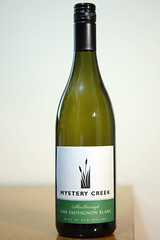I, with the help of some of my friends, generate a good deal of creative stuff. Some of it is sprinkled across a handful of websites (linked in the sidebar, so I won’t repeat them), some of it can be found elsewhere. My friends say to me quite often that I am the driving force behind our group – the one who gets things done.
We all come up with ideas. That’s the easy part. In a single lunchtime we often come up with a dozen or more ideas for things we could do. It’s an aphorism I’ve seen repeated several times in various contexts that “ideas are easy, execution is hard” – I saw it again the other day in an acquaintance’s blog. It really is true. Not to take any credit away from my friends – several of them also put in a lot of hard work behind the scenes to make our collective ideas come to fruition. I believe they just see me as the spur to get them going. :-)
Because as clichéd as it can sound, it really is true. Ideas are a dime a dozen. It’s doing something with them that is the hard work that few people can manage.
We have a sort of rolling conversation in our group about xkcd. There is some professional envy there, of course, since our own webcomics are nowhere near as popular, and it would be cool if they were. But that aside, we do have a genuine respect for Randall Munroe and what he does. it’s very easy for critics to say, “Huh, stick figures and geeky reference gags, anyone could do that.” But the point is anyone didn’t do it – Munroe did. He got off his butt and actually made the comics and made a website to put them on. And he’s continued making them – he didn’t quit after 3 weeks because it was taking too much time or effort.
There are a lot of failed creative ventures out there, where people had a cool idea and tried to do something with it, and gave up after a while because it was too much work. And there are even more where people had a cool idea and simply never got around to doing anything at all with it.
My determination is to actually put in enough effort to see an idea to fruition every now and then. Some of our ideas are non-starters, and some we put some effort into and then more or less abandon. But we keep trying, and some of the ideas do manage to reach a point where we can sit back and say, “Yes, we’ve done this idea.” Or even, “Yes, this idea is now up and running, and we are happy to dedicate some of our effort into maintaining it into the future.”
Someone once asked Harlan Ellison where he got his ideas from. He flippantly replied from a mail order business in Poughkeepsie. If he’d bothered to answer seriously, the real answer is that everyone has ideas. What people don’t have is the drive to do something with them. And because most people don’t do anything with their ideas, they end up thinking they don’t have any good ideas. That’s just wrong. If you have an idea for a story, or a blog, or a piece of artwork, or whatever, invest some time into making it happen. Get someone to goad you into it, if need be. It is hard work, but if you put that work in, you might get somewhere, as opposed to merely ending up envious of other people’s work and saying you could have done the same.
I didn’t intend this post to end on an accusatory downer. I’m sure some of you have put effort into creating something, or even started and then realised just how much work is required to bring an idea to fruition. You should be proud that you’ve achieved something which few others even bother to do. The external success of creative endeavours is determined by whims and the way the wind blows. But the internal success is determined by you and your hard work. Just because your stuff doesn’t become as popular as xkcd doesn’t mean it’s crap. Go! Create! And be proud of the effort you’ve put in. The hard work is what counts, not the success.




